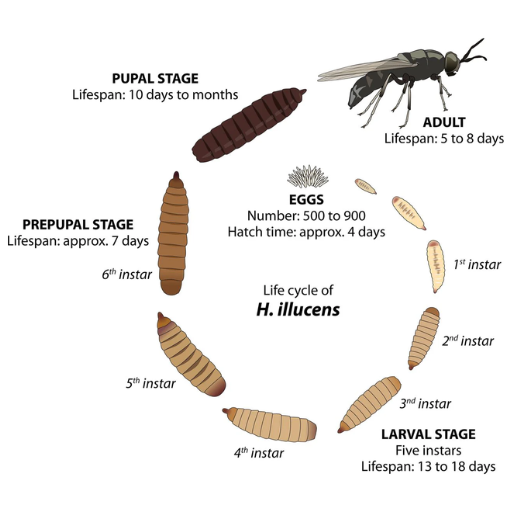The Black Soldier Fly (BSF) is becoming increasingly popular for its role in sustainable waste management and animal feed production. It is important for those who want to use them to understand the life cycle of BSF, especially the lifespan of its larvae. This article will discuss various stages of the BSF life cycle, focusing on how long it takes for larvae to develop, which has implications for composting and agricultural practices. We hope that by looking at this exciting insect’s biology, we can show its contribution to environmental sustainability and efficient waste breakdown – a process known as composting – among others.
What is the Black Soldier Fly Larva and What Is Its Importance?
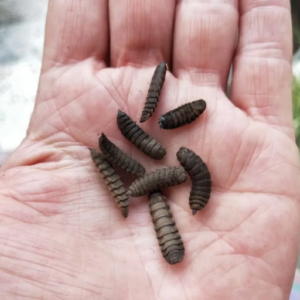
Image source: https://directcompostsolutions.com/
The Black Soldier Fly larva (BSFL) is the immature stage of the Black Soldier Fly, which comes from eggs laid by the adult female. These larvae can consume organic waste, such as food scraps and agricultural by-products, at an astonishing rate and turn it into nutrient-rich manure and biomass. This helps with proper waste management and cuts down on greenhouse gas emissions compared to traditional composting methods. Moreover, BSFL is a high-protein feed for livestock, poultry, and aquaculture, thus supporting sustainable animal husbandry practices. Their ability to convert waste efficiently while recycling nutrients makes them key players in environmental sustainability promotion and food security enhancement.
Introduction to Black Soldier Flies
Scientifically known as Hermetia illucens, Black Soldier Flies (BSF) are a type of fly that thrive in warm and wet habitats originating from tropical and subtropical regions. The life cycle of BSF consists of four stages: egg, larva, pupa, and adult; among these stages, the most significant one for waste management and feed production is the larval stage. Adults do not eat or live long but mainly concentrate on reproduction. At the same time, larvae can munch through all sorts of organic materials, thus effectively transforming waste into valuable materials. BSFs are being recognized more frequently due to their ability to decrease landfill mass, act as a sustainable protein source in animal feeds, and contribute to circular economy initiatives within agriculture as interest in sustainability rises.
Why are Black Soldier Fly Larvae Important in Composting?
Composting is a process where organic waste, such as food scraps and manure, is broken down into health-promoting fertilizers. In this regard, the Black Soldier Fly larvae (BSFL) play an important role because they decompose these organic materials efficiently. They can eat up to 50% of traditional composting methods, which speeds up decomposition significantly. Reducing waste volume during this rapid breakdown process contributes positively towards effective waste management practices since less garbage will be produced. In addition, they generate nutrient-rich frass (excrement), a high-quality organic fertilizer that improves soil health. Their presence in compost systems also controls odor and pests, thus creating balanced composting processes for environmental sustainability.
Nutritious Benefits of BSFL as Feeder Insects
Black Soldier Fly Larvae (BSFL) are becoming increasingly popular as a better feed option for different animals, particularly aquaculture and poultry production. The larvae contain a lot of proteins, which can be up to 45% of their total composition, which is critical for growth and development among young ones. BSFL also provides balanced essential amino acids that are fundamental for optimal health. Besides that, they have high amounts of good fats such as Omega3s and Omega6s, promoting better feed conversion rates. In addition to proteins and oils, the BSFL contains many vitamins/minerals, including Calcium, Phosphorus, and B Vitamins, making them an excellent supplement to improve overall diet quality or well-being in feeder animals. Growth efficiency and nutrient density attributes make BSF sustainable compared to conventional feeds, thus supporting environmentally friendly practices within livestock-raising industries.
How Long Do Black Soldier Fly Larvae Live?
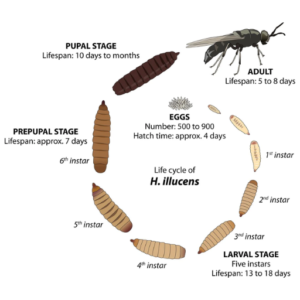
The lifespan of Black Soldier Fly Larvae (BSFL) can range from 14 to 21 days, and they go through a series of instars during this time, where they proliferate by feeding on organic waste. After reaching maturity, they enter into pupation for around 7 – 14 days before turning into adult flies, which signifies the end of their life cycle. The efficiency of its lifecycle is an important factor in sustainable waste management and animal feed production.
Typical Larval Stage Duration
Under optimal environmental conditions such as temperature (preferably between twenty-five degrees Celsius to thirty degrees Celsius or seventy-seven degrees Fahrenheit to eighty-six degrees fahrenheit) and humidity levels, the average duration for BSFL’s larval stage lasts approximately ten to fourteen days. During this period, larvae may pass several instar stages characterized by molting among these stages, thus marking rapid growth necessary for further development into pupae that last another seven -to fourteen days before becoming fully matured adults. An efficient lifecycle is critical to becoming a successful sustainable feed source while providing waste management solutions.
Factors Affecting the Life Cycle of the Black Soldier Fly
Several factors, such as temperature, humidity, the nature of organic substrates, and population density, influence the Black Soldier Fly’s (BSF) life cycle.
- Temperature: BSFL are most active in the warm temperature range of 25°C to 30°C (77°F to 86°F), and growth rate declines with exposure to temperatures outside this range, leading to longer lifespans and slower development instead.
- Humidity: The larvae require a highly humid environment for survival, which should be maintained at about 60%—80%. Conversely, desiccation may occur when humidity levels drop below average, harming the development process altogether.
- Organic Substrate Quality: Fast-growing BSFL can be achieved by feeding them nutrient-rich diets from different organic waste materials. However, quality substrates will slow down growth and reduce viability.
- Population Density: The density of larvae in a given space may modify growth rates and health. Competition for resources occurs under high densities, while optimal densities provide a supportive atmosphere for growth and development.
To improve waste management efficiency and sustainable feed source use among various farmers dealing with different kinds of research projects involving BSF farming, it is important that they learn how best to thrive these flies through manipulation or control over any factor affecting their life cycle.
What Happens When BSFL Turns into Flies?
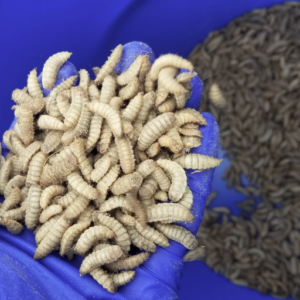
Pupation is the stage at which Black Soldier Fly larvae (BSFL) mature into adults. This process involves several drastic biological changes taking place within the larva as it transforms into a pupal form. Depending on environmental conditions, this stage lasts around five to seven days, after which adult flies emerge from the pupa. The adult black soldier fly can reproduce and plays an important role in ecosystems as a pollinator. However, these adults lack functional mouthparts and do not feed at all. Their primary purpose is reproduction and egg-laying to continue their life cycle. The emergence of adult flies marks the end of waste conversion, thus completing BSFL’s ecological contribution through its lifecycle.
The transition from Pupa to Adult Black Soldier Fly
The transition from pupation to adulthood in Black Soldier Flies (BSF) is a crucial stage in their life cycle. During this time, the larvae undergo significant morphological transformations that allow them to develop into fully formed flies. This stage usually takes five to seven days and can be affected by temperature or humidity levels, among other factors. After emergence as adults, these flies are concentrated solely on reproduction, their primary goal being mating, followed by egg-laying, which continues the reproductive cycle, thus increasing population size. Adult BSFs have wings for flight but no mouthparts, so they do not eat food. This adaptation enables them to concentrate all energy towards procreation instead of feeding themselves like most insects do. Their efficient life history also emphasizes how much waste management they perform in ecosystems where they play critical roles.
Understanding the Pupal Stage
The Black Soldier Fly (BSF) pupal phase is a critical stage where the larvae undergo a massive transformation. Within this stage, metamorphosis occurs as the larval body is rearranged and made ready for its adult form. This period usually lasts five to seven days but can be influenced by environmental conditions like temperature and humidity. At this point, not even an external disturbance can rouse the sleeping pupa that develops inside. To protect it from various dangers while allowing necessary changes to take place in its system, the pupa’s protective covering or puparium envelopes around it. It is important to know about this stage because it provides a vital link in the life cycle, which eventually supports BSF’s ecological role in waste conversion and nutrient cycling.
Can Black Soldier Fly Larvae be Used as Pet Food?
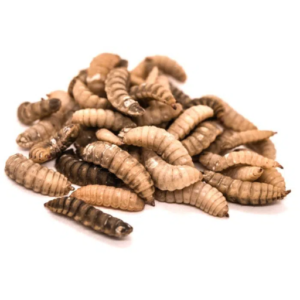
Indeed, the larvae of the Black Soldier Fly (BSF) have become a fashionable choice in pet food. They are an excellent source of nutrition, with high levels of protein, fats, and essential amino acids that are good for pets. The larvae can be fed to many different animals, such as reptiles, birds, and even some mammals, which helps improve their overall health and energy levels. Furthermore, BSF larvae provide sustainable alternatives because they can be raised on organic waste, thus making them eco-friendly options for pet owners who want to lessen their environmental impact.
Feeding BSFL to Reptiles and Birds
Due to their nutrient-rich composition, Black Soldier Fly larvae (BSFL) are ideal food for reptiles and birds. The protein and fat from BSFL are beneficial for reptiles as they promote healthy growth and provide energy. However, BSFL should be given sparingly as part of a balanced diet that includes other appropriate foods according to the specific dietary needs of different reptile species.
For birds, especially insect-eating ones, adding BSFL can significantly enrich their diet because they are highly concentrated in essential amino acids. Depending on personal preference, birds may prefer fresh or dried larvae. To monitor any potential changes in behavior or health after introducing this new food into your pet’s diet, start with a small amount at first; always keep in mind, though, that you want to see how well it fits within the overall nutritional requirements for that particular bird type before increasing portions further. Ensure pest sources come from trustworthy suppliers, so there is no risk involved with feeding them anything harmful or lacking nutritional value, which could lead to later problems.
Benefits of Gut-Load for Feeder Insects
Gut-loading involves feeding feeder bugs a nutrient-rich food before giving them to pets. This practice greatly increases the nutritional value of these insects, making sure reptiles and birds get vitamins and minerals that are missing from their regular diet. The following are some benefits of gut-loading feeder insects:
- Better Nutrition: Pet owners can help insects carry more vitamins (like A, D3, and E) and minerals (such as calcium) by feeding them a balanced diet. This will enhance the health of the pets that eat such insects.
- Improved Animal Health: Increased nutritional value can support better growth, energy levels, and immune function in reptiles and birds that easily suffer from dietary deficiencies. This leads to healthier animals with fewer chances of getting sick.
- Tastier: Pets find it easier to eat gut-loaded insects because varied diets improve their taste and texture, encouraging consistent feeding and reducing fastidiousness among picky eaters.
To sum up, gut-loading feeder insects enhance the nutrient profile and promote overall welfare for pet lizards, parrots, etc.
Using NutriGrubs as a Food Source
Reptiles and birds can be fed NutriGrubs from Black Soldier Fly Larvae (BSFL). These larvae are nutritious alternatives for pet food since they are packed with proteins, healthy fats, and essential amino acids. Here are some benefits of NutriGrubs according to reputable sources:
- High Nutritional Value: Because of their high protein content, sometimes even higher than that of traditional feeder insects, NutriGrubs have been recognized as the best choice for active pets that are still growing.
- Sustainable Option: Sourcing these products is eco-friendly, as black soldier fly larvae convert organic waste into quality proteins, thus promoting sustainable diets.
- Convenience and Availability: More suppliers are now stocking them, making it easy for pet owners who want to diversify what they feed their animals to find this convenient yet nutritious product.
Pet owners should include Nutri grubs in their feeding plans to provide a balanced diet that promotes the health of reptiles and birds.
Does BSFL Bite or Cause Any Harm?
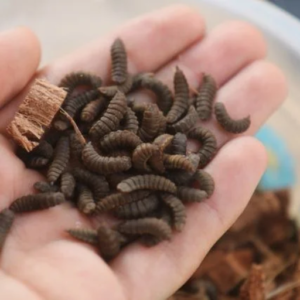
Black Soldier Fly Larvae (BSFL) do not pose a threat to reptiles, birds, or humans and are generally regarded as safe. Pets cannot hurt them because they lack biting mouthparts. In addition, BSFLs are noninvasive and carry no known animal diseases. Their gentle nature allows them to be included in pet diets without fear of aggression or harm.
Common Myths About Black Soldier Fly Larvae
- Myth: BSFL are Invasive Pests
Contrary to popular belief, black soldier fly larvae are not invasive. They do not survive outside composting environments and, therefore, do not cause problems in natural ecosystems. Waste reduction is one area where they can positively contribute to controlled environments that contain their lifecycle.
- Myth: BSFL Carry Diseases
Another common misconception about black soldier flies is that they can transmit diseases to pets. These larvae are actually raised under clean and controlled conditions, which greatly minimize the risk of disease transmission between them and our beloved animals. Moreover, their digestive system has properties that allow them to eat harmful pathogens found in organic waste while detoxifying them at the same time.
- Myth: BSFL are Hard to Digest for Pets
Some people worry that reptiles and birds will find it hard to digest these organisms. Still, this fear should not exist since protein content from fat within the body provides essential nutrients without causing any gastrointestinal issues for pets. Quite the opposite, many pet owners have noticed noticeable improvement in health after introducing this new diet into their lives!
Safety of Handling BSF Larvae
Generally, handling BSFL is safe as long as hygiene practices are maintained. To avoid contamination of any sort, it is vital that one washes one’s hands thoroughly before and after handling the larvae. While the Black Soldier Fly Larvae (BSFL) are noninvasive and do not carry diseases that can be harmful to pets, washing one’s hands after touching them decreases the risk posed by bacteria in the environment.
When working with larger amounts of these pests, gloves are also suggested. Many experts recommend obtaining BSFL from reputable vendors who rear them under strict hygiene conditions. Proper storage should be observed and kept clean to ensure safety for both the handler and his or her pet(s). Always watch your furry friends closely whenever you introduce new food sources into their diets, including BSFLs.
Comprehensive Guides on Black Soldier Fly Uses
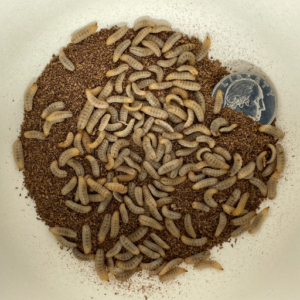
The Black Soldier Fly Larvae (BSFL) have become popular in many areas.
- Animal Feed: BSFL is an excellent source of protein for livestock, poultry, and aquaculture. It boosts growth and health, making it a much better choice than conventional feeds due to its great nutritional value.
- Waste Management: These insects break down organic waste into compost rich in nutrients while reducing its volume. This helps address the problem of waste disposal and promote sustainable farming practices.
- Soil Fertilizer: The waste produced by BSFL during breeding is called frass, a great organic fertilizer that nourishes the soil with important elements and improves its structure.
- Human Consumption: Although not very common, BSFL can still be processed into different forms for human consumption, thereby providing alternative sources of sustainable protein.
- Research and Development: Bioconversion, bioremediation, and biofuel production involving BSFL are being studied continually, thus showing how these worms can solve various contemporary sustainability problems.
If you know about these uses, industries should use them to manage resources better and find nutritional solutions using BSFL.
Best Practices for Breeding and Raising BSF
When breeding and rearing Black Soldier Flies (BSF), here are some best practices taken from top sources that are worth considering:
- Control the Environment: To create ideal conditions, ensure warm temperatures around 25-30°C (77-86°F) with sufficient humidity. Since BSF likes dark places, providing shaded areas that mimic their natural habitats is advisable.
- Feeding: Organic waste materials such as vegetable scraps, fruits, or grain by-products should be used as feed. It’s crucial to ensure the feeding stuff isn’t fermented or odorous, so monitor moisture content to avoid rotting.
- Space Management: Larvae require enough space for development; otherwise, stress due to overcrowding will affect growth negatively. The design should facilitate easy collection of larvae while allowing continuous addition of new organic material for feeding purposes.
- Lifecycle Monitoring: Always keep an eye on the life stages of BSF, including eggs, larvae, and pupae, at regular intervals. Knowledge about these stages plays a key role in determining optimal harvest times, which ensures a constant supply of larvae throughout year-round periods.
- Bioconversion Processes: Effective bioconversion methods should be employed to improve waste processing systems’ efficiency. To speed up the breakdown process, thus minimizing bad smells and pests, consider using layered systems during organic materials’ decomposing activity.
These guidelines will help you create an environment conducive to BSFs’ well-being, enhancing their roles in waste management and nutrient-cycling activities.
Frequently Asked Questions (FAQs)
Q: What are some common names for black soldier fly larvae?
A: Black soldier fly larvae are known as phoenix worms®, calciworms®, and BSFL. The scientific name for the black soldier fly is Hermetia illucens.
Q: How long do black soldier fly larvae last before they start to pupate?
A: Under optimal conditions, black soldier fly larvae can live for about 45 days before they start to pupate. Conditions such as temperature, humidity, and food availability impact this duration.
Q: Is BSFL good for my pet?
A: BSFL (Black Soldier Fly Larvae) is highly nutritious and an excellent live feeder option for various pets. They are rich in calcium and protein, making them an excellent choice for reptiles, amphibians, and birds.
Q: What should I do when my black soldier fly larvae arrive?
A: When your soldier fly larvae arrive in a small plastic container, they should be kept at room temperature or in a wine cooler if you need to store them for an extended period. Ensure they have a proper substrate to thrive.
Q: How long can black soldier fly larvae survive without food?
A: When kept properly, black soldier fly larvae can survive for several weeks without food. However, they should have adequate substrate and food to maintain their health and growth.
Q: What happens during the pupae stage of the black soldier fly?
A: In the pupae stage, black soldier fly larvae turn dark and become less active as they prepare to transform into adult flies. This stage occurs after they have reached their final instar and lasts about 14 days under optimal conditions.
Q: How do black soldier flies affect the pet industry?
A: Black soldier flies are highly valued in the pet industry for their larvae, which are used as a nutritive feed for various pets. They contribute to sustainable food waste management and provide a healthy alternative to traditional live feeders like crickets and mealworms.
Q: Why do black soldier flies lay eggs in food waste?
A: Black soldier flies prefer to lay their eggs in decomposing organic matter, including food waste. Once the eggs hatch, this environment provides abundant food for the emerging larvae.
Q: Can black soldier fly larvae become too cold?
A: Black soldier fly larvae can become too cold for optimal development. They should be kept at room temperature or slightly cooler (around 55°F in a wine cooler). Keeping them too cold can delay their growth and pupation.













